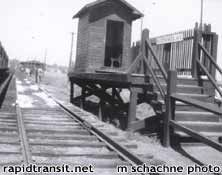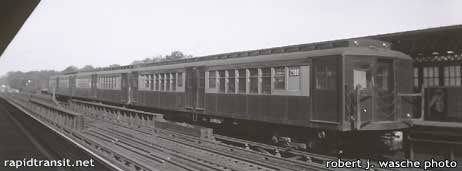
Page 13

It was evident by the mid-60s that the SIRT's days as a B&O subsidiary were numbered, and it was equipment shortages that tipped the balance. The fleet was aging, and the portents were not in the SIRT's favor.
The SIRT needed all but four of its cars for rush-hour service, an uncomfortably small margin. The road maintained service by careful scheduling of shop maintenance and some "heads-up" railroading. Schedules were carefully planned and, after dropping their loads in the evening rush, a number of trains were rushed back to St. George as passenger-free expresses.
It was too late to regain any of the equipment sold to the Transit Authority, even if the TA had not already consigned the cars to the torch. The equipment had been modified and not well-maintained. Ironically, there seemed a real possibility that some of the SIRT cars' older cousins from the BMT might provide a breather.

Selling the cars proved a bad decision, however. When yet another fire, at Clifton Shop on April 5, 1962, claimed another seven cars atop the 13 lost in two previous fires and two otherwise scrapped, the SIRT was left with only 48 cars, an uncomfortably close number to that needed for operation.
Staten Island
Gets Connected, But...
November 21, 1964 was a big day for Staten Island with the opening of the Verrazano Bridge across The Narrows. Unhappily this was not the connection that the SIRT had hoped for since the early days of the century. As it had always been in projects masterminded by Robert Moses rapid transit was forbidden, out-of-hand, from operating across the handsome new span.
In 1965 and 1966, the SIRT saw the elimination of its final set of grade crossings through Jefferson Avenue and Grant City. A shoo-fly track was constructed to the east of the original line while a new crossing free line was constructed along the original alignment. Upon completion of the project, the SIRT joined the ranks of fully grade-separated rapid transit operations.
South Beach Plus One. Though South Beach was nominally the last stop on the branch of the same name, passengers could be carried an additional station to Wentworth Avenue, undoubtedly the shortest rapid transit station passenger station in the world. Its platform accomodated a single door of one car.
Nine BMT Standard B-type cars were set aside for possible transfer to the SIRT. The SIRT also received and examined a proposal for the acquisition of some D-type cars, including a list of the measures needed (surprisingly few) to allow the cars to meet FRA requirements. Neither transfer came to pass.

SIRT Cars on the BMT At Last! Though not what SIRT planners envisioned in 1925, these SIRT cars made it to New York City Transit Authority tracks as additional equipment to help alleviate the BMT Division's chronic car shortages. They saw most of their service on the Culver-Nassau route (shown here at Ft. Hamilton Parkway station), but also spent a bit of time on the West End Short Line and Franklin Shuttle. In 1961, deliveries of new R27 cars sent these and other surplus BMT cars to the torch.
Updated
©1965 Silver Leaf Rapid Transit. ©2001 Paul Matus. ©2001 The Composing Stack Inc.